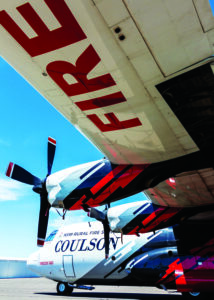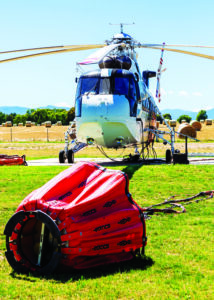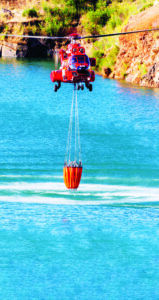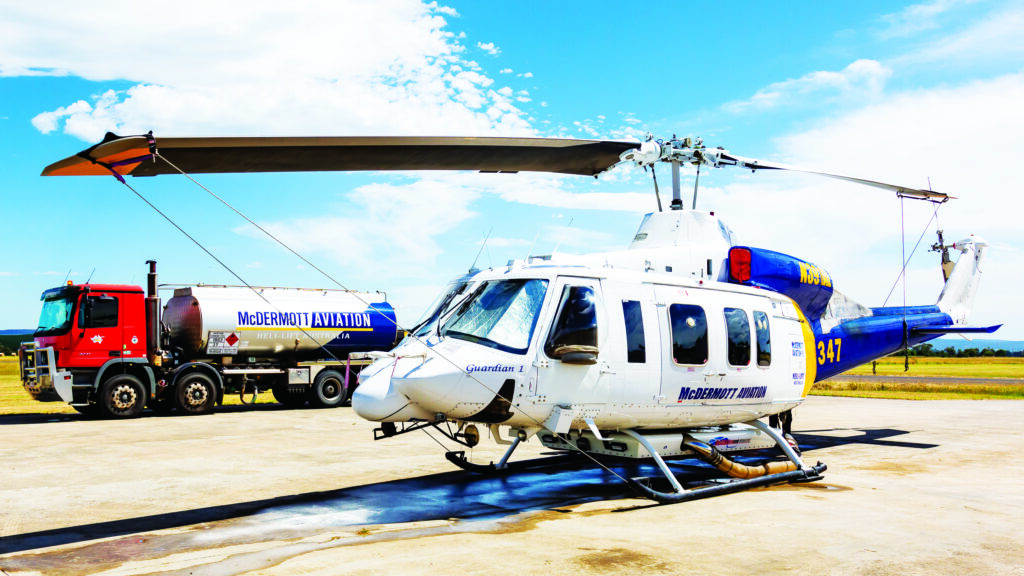As the Fire Season in Australia ends for the 2021/2022 season, we look back on the highs and lows. The country had a mixed season, with much less fire activity compared to previous years. Australia’s Eastern states had high rainfall and lower temperatures during the season. Western Australia and Tasmania saw the largest fires this season, with assets deployed from other states to support their operations. In Western Australia, the state recorded 2216 bush/scrub fires from November through February.
Fire and Rain were not the only issues this season as the Australian Government persisted with intense Covid 19 scrutiny as other countries returned to normal. Covid-19 protocols were causing logistics delays with foreign operators importing firefighting equipment. Ship space this year was and continues to be a significant issue. The demand for global freight will see this issue continue in the short term. These delays will see a high likelihood of airframes being forced to move by cargo aircraft to meet timelines set out by fire agencies worldwide.

Western Australia had the most significant fleet additions over the summer period with two additional Bell 412’s based at RAAF Base GinGin; the NSW-based LAT Bomber 210 was based at Busselton and Geraldton for some time, along with the NSW-based RJ85 and the C-130 at Busselton. The fire support and spotting fleet also grew due to the number of fires lit deliberately or by dry lightning.
Australian states continue their investment in locally-based and owned assets. The Western Australian Government has committed funds to acquire a large air tanker (LAT) on lease to be based in the state for the next four fire seasons. This is due to previous years establishing a large air tanker in the state. If required, the aircraft would fly to where it was needed. Procuring a state-based LAT means Western Australia will have its capabilities for LAT deployment when required for future fire seasons.
The Australian Federal Government’s contracted 737, which spent most of its time in Western Australia this season, performed 76 drops totaling 984,557 liters/260,000 US GAL of retardant this summer, while borrowed LATs from other States performed 41 drops totaling 460,964 liters/122,000 US GAL of retardant. The rise in usage of LAT aircraft in Australia continues to grow, with the South Australian Government soon announcing the purchase of a LAT.
The Victorian and Queensland governments currently share joint use of a Conair-owned and FieldAir-operated Dash-8 Q400MR over the next four years. Now, the Australian states of the Australian Capital Territory, Tasmania, and the Northern Territory are without LAT support. The widespread use of LAT assets that has continued to grow over the last several years is a far cry from the single LAT program that the Victorian Government struggled to get off the ground in the early 1980s.

Nationwide Equipment
This season saw type one Black Hawk helicopters based in Australia. Adding Blackhawks to the firefighting fleet replaced several Erickson Skycranes missing from this year’s fleet from overseas. There was much said by many firefighters across the country this year about the lack of the heavy-hitting Skycrane not being in the skies as an additional asset to the international fleet.
As the Australian fleet primarily consists of Bell-type two and three aircraft that are becoming increasingly harder to find parts for, the natural progression is now moving into more modern aircraft types that allow easier maintenance and parts acquisitions. These newer acquisitions include Blackhawks and the much larger Airbus Super Puma.
 Erickson Inc returned to Australia with just one of the company’s famous S-64F Air-crane that arrived at the docks in Melbourne on January 17th and became Helitak 342. The helicopter was based at Moorabbin Airport for its entire season.
Erickson Inc returned to Australia with just one of the company’s famous S-64F Air-crane that arrived at the docks in Melbourne on January 17th and became Helitak 342. The helicopter was based at Moorabbin Airport for its entire season.
Kestrel Aviation further increased its Australian fleet under the guidance and owners Ray and Elenore Cronin; a new type was introduced into the company stable as the Airbus Helicopters AS355L1 Super Puma was added.
Coulson Aviation again played a large part in local fire operations, taking a contract in Western Australia and regular contracts in Victoria and New South Wales. The NSWRFS awarded contracts to Coulson for the supply of a Large Air Tanker (LAT), which was operated by a Lockheed C-130Q N131CG, and a Type 1 Helicopter which was a first for the NSW RFS.
Coulson inducted the CU-47D N40CU and was the first type contracted through NAFC. The Coulson fleet consisted of one Boeing 737-300, one EC-130Q Large Air Tanker, two CU-47 Chinooks, and one S-61.

The Victorian Government awarded contracts for the supply of two Type 1 helicopters. The first delivered was the Sikorsky S-61 C-FXEC returning for another season and now wearing the company’s corporate color scheme. It took up operations at the firebase at Mansfield in the state’s high country. The second was the first of the type for Victoria with the Boeing CU-47D Chinook N42CU. Once it was assembled at the docks in Melbourne after arrival in January, it took up the Helitak 341 number and operated from Essendon Fields Airport.
A further contracted LAT was allocated for use as part of the National Sovereign Large Air Tanker contract. This aircraft, a Boeing 737 Fireliner, saw extensive service in Western Australia while based at Busselton in the state’s south and was at times supported by the NSW RFS Boeing 737 Bomber 210, the Marie Bashir, and Coulson C-130Q from NSW, which arrived at Busselton from Richmond, NSW. It was based at Busselton temporarily to assist in fighting a large bushfire at Margaret River. After helping with the fire in Western Australia, the two aircraft returned to Richmond on December 12th, 2021.
New South Wales, instead of fire danger this season, was subject to high rainfall with the NSW RFS-owned, Coulson-operated Bell 412 helicopters used for months on flood response in NSW. The NSW-based CU-47 also assisted in flood relief after its tank was removed to fly missions airlifting supplies to affected communities.
In late February, Coulson received approval from CASA to conduct night fire suppression operations under Night Vision Goggles (NVG) in Australia using the CU-47D very large helitanker. This operation has been performed by Coulson pilots and aircraft both successfully and safely in night fire suppression operations in CU-47D very large helitankers for several years in North America and the Type one S-61 helitankers in Australia.
On December 23rd, 2021, the Australian Government welcomed the first-ever National Sovereign Large Air Tanker, a Boeing 737 Fireliner ‘Gaia’ arrived at RAAF Richmond. It was soon deployed to Western Australia to assist with firefighting operations in that state.
Aerotech First Response increased its presence in South Australia this year. The company won contracts to supply two UH-60 Blackhawks type 1 helicopters. Aerotech purchased two ex-US Army Blackhawks and was the first and currently only Australian-based operation with Blackhawks to have them on the VH (Australian civil) register and be fitted with the Helitak FT4500 underbelly tank.
 Joining the Aerotech fleet was Air Tractor VH-XPB. This machine flew as Bomber 593 and is part of the XO Aviation fleet based in Parap in the Northern Territory. This aircraft supplemented the Aerotech Air Tractor fleet, which again took up operation from the airbase in Claremont in the Mount Lofty Ranges along with operations from Mt Gambier, Port Lincoln, and Hoyleton. Joining them were helicopter platforms, including EC-130, VH-HQL (Firebird 502) and EC-135 VH-LHZ (Firebird 503), and EC-135 VH-HBB (Firebird 501).
Joining the Aerotech fleet was Air Tractor VH-XPB. This machine flew as Bomber 593 and is part of the XO Aviation fleet based in Parap in the Northern Territory. This aircraft supplemented the Aerotech Air Tractor fleet, which again took up operation from the airbase in Claremont in the Mount Lofty Ranges along with operations from Mt Gambier, Port Lincoln, and Hoyleton. Joining them were helicopter platforms, including EC-130, VH-HQL (Firebird 502) and EC-135 VH-LHZ (Firebird 503), and EC-135 VH-HBB (Firebird 501).
McDermott Aviation Took up more contracts this season, further increasing the company’s supply of aerial firefighting platforms. Yellow and Blue painted McDermott machines were seen in Western Australia, Queensland, Victoria, Tasmania, and New South Wales. Before the start of the Southern season, six of the companies Bell Helicopters were deployed to Greece in the Northern season for fire operations from locations around the country.
 Four of them were flown to Greece as cargo in the belly of an Antonov AN-124. Two were loaded at Wellcamp Airport (Toowoomba) in Queensland, with another two picked up and loaded at Perth Airport and onward to Greece. The Greece contract finished in October with preparations for shipping the helicopters back to Australia. Of note was the operational tempo during their time in Greece. For two months, over 155 flight hours consisted of 986 water drops, dropping 2,460 tons of water during firefighting operations in Greece. No small feat by just six helicopters.
Four of them were flown to Greece as cargo in the belly of an Antonov AN-124. Two were loaded at Wellcamp Airport (Toowoomba) in Queensland, with another two picked up and loaded at Perth Airport and onward to Greece. The Greece contract finished in October with preparations for shipping the helicopters back to Australia. Of note was the operational tempo during their time in Greece. For two months, over 155 flight hours consisted of 986 water drops, dropping 2,460 tons of water during firefighting operations in Greece. No small feat by just six helicopters.
 McDermott had six helicopters on Contract in Western Australia, five in Queensland, two in New South Wales, six in Tasmania, and three in Victoria. McDermott continues to affirm their commitment to aerial firefighting in Australia and abroad, with additional machines on their way to be added to the fleet.
McDermott had six helicopters on Contract in Western Australia, five in Queensland, two in New South Wales, six in Tasmania, and three in Victoria. McDermott continues to affirm their commitment to aerial firefighting in Australia and abroad, with additional machines on their way to be added to the fleet.
Six McDermott helicopters were flown to Fremantle Docks in Western Australia for forwarding shipping to Greece, where they will again support Greece fire agencies. This marks the third year of these operations for the two organizations.
United Aero Helicopters has been a fixture in fire operations in NSW for many years. This season United took the opportunity to increase its types operated. Following the purchase from Pickering Aviation Inc in Denton, Texas, United took delivery of UH-60A Blackhawk N260UH. Once it arrived in Sydney, it was ferried to Camden, NSW.
A Helitak FT4500 belly tank was fitted, tested, and certified for operation. It was flown from Camden, arriving at Serpentine, WA, on January 12th, 2022. It was based at Serpentine until April 2022, operating on contract to the Western Australian Government, under the control of the Department of Fire and Emergency Services (DFES).
The company also deployed a second Blackhawk to the West, with this machine being owned by Kahu NZ in Whakatane in New Zealand. ZK-HKU a Sikorsky EH-60A was flown from its base in Serpentine WA as Helitak 679. Once again, this machine was equipped with a Helitak underbelly tank. Both machines were used extensively in the West as fires were rife across the state.
 Field Air took up contracts in several states this season. One which saw a collaboration between the Queensland and Victorian Governments saw Conair-owned Dash-8-Q400 C-FFQE arrive in Bundaberg, where it operated as Bomber 141 on behalf of the Queensland Fire Service.
Field Air took up contracts in several states this season. One which saw a collaboration between the Queensland and Victorian Governments saw Conair-owned Dash-8-Q400 C-FFQE arrive in Bundaberg, where it operated as Bomber 141 on behalf of the Queensland Fire Service.
At the end of the contract in Queensland in December, the aircraft was positioned at its new operating base at Avalon Airport in Victoria. It changed its logos and bomber number to 390 and was ready for its Victorian contract. This shared platform will be permanently based within Australia for the next three seasons. It will be hangered at Avalon in the offseason before repositioning to Queensland again for the 2022/23 season.
The company was also contracted to deploy two Large Air Tankers (LATS) for the Victorian and New South Wales fleets in the form of BAe RJ-85s. Based at Avalon and Dubbo, respectively, were two Conair aircraft. With C-GVFK taking up the Bomber 391 number in Victoria and C-GVRT Bomber 166 for New South Wales. Both aircraft worked on fires across borders this season. The Victorian machine worked on a fire that originated in South Australia and crossed into Victoria. The NSW aircraft was sent to assist with the fires in Western Australia in early December and worked out of Busselton Firebase during its time there.
Sydney Helicopters deployed on significant operations for its Bell 412s this season. The aircraft flew from their Penrith base in NSW via multiple stops to RAAF GinGin on 16-18 December 2021. The trip was a logistical and well-planned operation with fuel truck support from TechFuel, meeting the two machines at pre-planned stops along the transit route. All of this was done while Western Australia still has a hard border with the rest of the country.
Microflite was another local operator who expanded this season. Not only in fleet numbers but also in its number of contracted helicopters. Microflite secured contracts for helicopter operations in Victoria, Tasmania, and the ACT. They provided helicopters for roles including Air Attack Supervision, Intelligence gathering, and firebombing. A purchase of a second-hand ex Miami-Dede County Bell 412 and fitting it with a Helitak FT1800 belly tank.
Touchdown Helicopters was another operator this season to branch into Blackhawk operations. Teaming up with US operator HeliQwest, the two companies brought out N61AA, equipping it with a Helitak HT4500 underbelly tank, operating from Bankstown for the season as Helitak 233.
 Helitak Fire Fighting Equipment, the Australian company that produces underbelly tanks for aerial firefighting operations, has seen significant growth in its home market segment, with no fewer than six Blackhawks deployed across the country operating with its tanks fitted. A massive uptake by local agencies and the quick fit solution offered by the tank has invigorated sales. Owner Jason Schellars and operations manager Paul Blundell continue to market the tank overseas. With further orders coming for more Blackhawk tanks.
Helitak Fire Fighting Equipment, the Australian company that produces underbelly tanks for aerial firefighting operations, has seen significant growth in its home market segment, with no fewer than six Blackhawks deployed across the country operating with its tanks fitted. A massive uptake by local agencies and the quick fit solution offered by the tank has invigorated sales. Owner Jason Schellars and operations manager Paul Blundell continue to market the tank overseas. With further orders coming for more Blackhawk tanks.
A new venture was made public in January as Arista Aviation Services in Alabama will soon offer the Helitak expandable tanks to customers wanting to operate with a fixed belly tank requiring no airframe modification and no extended landing gear installation for all helicopter types.
See more images from Aviation Spotters Online who provided the images for this story.






























